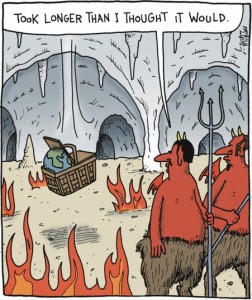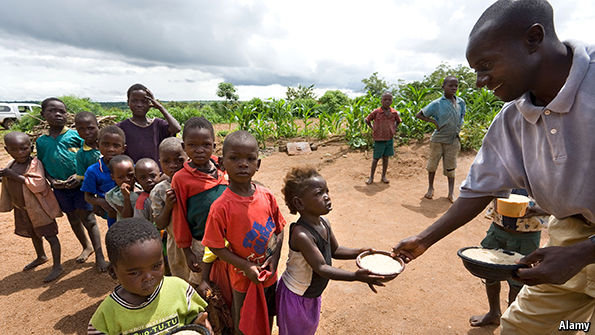Stephen Colbert did an incredible bit on Sarah Palin’s endorsement of Donald Trump. It begins with Colbert enjoying Palin’s strange speech, and then he Palin-endorses the other presidential candidates. I only wish he had done Bernie Sanders. Enjoy.
News
2015: The Best Year in Human History

The Atlantic cuts through much of the pessimism found in the media with data that should make us smile:
From Paris to Syria through San Bernardino to Afghanistan, the world witnessed obscene and unsufferable tragedy in 2015. That was on top of the ongoing misery of hundreds of millions who are literally stunted by poverty, living lives shortened by preventable disease and malnutrition. But for all of that, 2015 also saw continued progress toward better quality of life for the considerable majority of the planet, alongside technological breakthroughs and political agreements that suggest the good news might continue next year and beyond.
And their evidence?:
- A 35% decline in violent crime rates in the U.S. since the 1995, with a 6% drop in homicide rates worldwide between 2000 and 2012.[ref]Based on countries for which data was available.[/ref]
- While terrorism and war is up slightly in the last couple years, “across the globe, the numbers of ongoing wars and battle deaths are still far below their levels of the 1970s and 1980s. Furthermore, terrorism, war, and murder together remain a minor cause of death worldwide.”
- “Famine deaths are increasingly rare and increasingly limited to the few areas of the world suffering complete state collapse. Related to that, the proportion of the world’s population that is undernourished has slipped from 19 percent to 11 percent between 1990 and today.”
- Vaccines have nearly exterminated diseases like polio and measles, while new ones (such as the recent one to combat Ebola) may prevent future outbreaks. “Meanwhile, the UN reported this year that global child mortality from all causes has more than halved since 1990. That means 6.7 million fewer kids under the age of five are dying each year compared to 1990.”
- “[T]he number of electoral democracies worldwide remains at a historic high…”
- Greater LGBT rights worldwide.
- Increased wealth worldwide.
- Increased globalization.
- Increased commitment to battling climate change.
Chris Smith over at Approaching Justice has his own list of “good news” stories from 2015, including:
- Advances in treatments for cancer and Alzheimer’s.
- Plummeting U.S. school dropout rates.
- Women in Saudi Arabia voting and running for office for the first time.
And much more. Check out these links and remember that despite the bad news, the world continues to get better.
Happy New Year.
World Bank: End Extreme Poverty by 2030
 The World Bank reported last month that for the first time in world history, extreme poverty will likely fall below 10% of the global population this year. This is encouraging and provides strong evidence that the goal of eradicating extreme poverty worldwide by 2030 is achievable. World Bank Group President Jim Yong Kim said,
The World Bank reported last month that for the first time in world history, extreme poverty will likely fall below 10% of the global population this year. This is encouraging and provides strong evidence that the goal of eradicating extreme poverty worldwide by 2030 is achievable. World Bank Group President Jim Yong Kim said,
This is the best story in the world today — these projections show us that we are the first generation in human history that can end extreme poverty…This new forecast of poverty falling into the single digits should give us new momentum and help us focus even more clearly on the most effective strategies to end extreme poverty. It will be extraordinarily hard, especially in a period of slower global growth, volatile financial markets, conflicts, high youth unemployment, and the growing impact of climate change. But it remains within our grasp, as long as our high aspirations are matched by country-led plans that help the still millions of people living in extreme poverty.
Poverty continues to be concentrated in Sub-Saharan Africa and South Asia, yet both have seen reductions in poverty: South Asia dropped from 18.8% in 2012 to 13.5% in 2015 and Sub-Saharan Africa dropped from 42.6% in 2012 to 35.2% in 2015.
This is one of the greatest stories never told.
China Ends One-Child Policy
China ended its one-child policy this week, changing instead to a two-child policy. I don’t have much to say about it. A horrific, gendercidal attempt at social engineering that has led to immense human suffering has been softened. Yet, it is not enough. Sadly, as The Economist notes, many of those who wanted a second child have already been sterilized. I’m going to control myself and not lash out in anger over the lack of attention on my Facebook news feed or what seems to be actual support for the one-child policy in one form or another. Instead, I’ll just do what I usually do and post data:
Based on the now debunked threat of overpopulation that was popularized by Stanford University scholar Paul Ehrlich, the communist government subjected the Chinese people to forced sterilizations and abortions. Many newborn babies were either killed or left to die. Today, the Chinese population suffers from a dangerous gender imbalance that favors boys over girls at a ratio of 117:100, and a demographic implosion that threatens future economic growth and prosperity. In fact, as Human Progress advisory board member Matt Ridley shows in his book The Rational Optimist, population growth and economic expansion go hand in hand. The horrific consequences of the Chinese one-child policy are a reminder of what happens when governments are allowed to interfere in the deeply personal decisions of individual citizens and their families.

The claims of overpopulation doomsdayers were wrong. But those claims brought about immense misery. Let’s be grateful that we’re moving in a better direction.
Angus Deaton: Nobel Prize in Economics
 Princeton economist Angus Deaton was awarded the Nobel Prize in economics earlier this week. “Deaton’s work,” reports Reason, “has focused on how to reconcile economic theory with economic data, specifically looking at various measures of well-being, health, inequality, consumption, and economic growth.” His book The Great Escape: Health, Wealth, and the Origins of Inequality is a nice summary of his work. Deaton’s work shows how crucial it is to compare models to reality. Furthermore, it is a nice reminder that the world in many respects is getting better.
Princeton economist Angus Deaton was awarded the Nobel Prize in economics earlier this week. “Deaton’s work,” reports Reason, “has focused on how to reconcile economic theory with economic data, specifically looking at various measures of well-being, health, inequality, consumption, and economic growth.” His book The Great Escape: Health, Wealth, and the Origins of Inequality is a nice summary of his work. Deaton’s work shows how crucial it is to compare models to reality. Furthermore, it is a nice reminder that the world in many respects is getting better.
Check out his lecture below.
Sustainable Development Goals
 The UN recently had a meeting to unveil the Sustainable Development Goals. As The Economist reported,
The UN recently had a meeting to unveil the Sustainable Development Goals. As The Economist reported,
Most of the SDGs’ predecessors, the Millennium Development Goals (MDGs), have been met, largely because of progress in China and India. But there were just eight of them, focused on cutting extreme poverty and improving health care and education, all clearly defined. By contrast there are 17 SDGs and a whopping 169 “associated targets”, covering world peace, the environment, gender equality and much, much more. Many are impossible to measure. They are “higgledy-piggledy”, agrees Lord (Mark) Malloch-Brown, who helped write their predecessors. A tighter focus and more precise definitions might have been wise. Even so, the SDGs are part of an important shift in thinking about development that is making it both more ambitious and more realistic.
What makes these new goals exciting is that they are attempting to sway “governments, private enterprise and civil society” into working “together to create open societies and open economies, end conflict and corruption, and enshrine the rule of law, free speech and property rights.” Furthermore, “the main reason there are so many is that they were set by consensus rather than written by a few specialists, mostly from rich countries. This lessens the feeling that rich men from “the north” are telling “the south” how to do better.” I’m inspired by this because “poor-country governments and rich-world aid lobbies have become less hostile in recent years to the idea that free markets and big business can help cut poverty. Multinationals were wary when the MDGs were unveiled, says Lord Malloch-Brown; now many are on board. And some rich-as-Croesus philanthropists, together with a bevy of market-friendly think-tanks, have started to monitor and measure the results of aid spending, and to search for ways to make it more effective.” In other words, governments and other institutions are worried about actually helping the poor rather than just feeling better about themselves by giving aid. The Economist concluded its report:
As the SDGs proliferate, donors are putting greater emphasis on measuring results and collecting data. They need data to be more disaggregated and to know where the poor are concentrated, as well as their ages, how they live and what sort of work they do. Advances in technology make this easier. Satellites can more precisely determine where forests are thinning, for example, or where crops are thriving or wilting. Among the SDG targets is one that calls for all births to be registered so that all children have legal identities, and their progress can be tracked…The MDGs were meant to create a social safety net; the SDGs to be fit for an age in which the standard of living in a big chunk of the developing world is creeping towards the levels of rich countries. The SDGs’ boosters, though admitting they will be harder to measure than the MDGs, let alone meet, hail them for going “beyond aid”.
NYT Op-Ed: Buying Sex Should Not Be Legal
Another way of stating that is “buying women should not be legal”. [ref]This of course applies to men and children as well.[/ref] The latter statement seems more clear, or at least I assume it is, given Amnesty International’s potential call to end laws against sex work for all involved, for the sake of “human rights”. Because nothing says human rights of women like legalizing the roles of pimps and johns, whatever they do to “their” women.

The NYT has posted a great op-ed discussing the (lack of) merits of such a legal move. I’ve yet to read a convincing argument on how decriminalizing pimps and johns actually protects women, but in this op-ed we get a real solution to the abuse, force, and trafficking that often goes hand-in-hand with sex work. The author, Rachel Moran, was once a sex worker herself, beginning at the age of 15 (does that look like human rights to you?). She suggests making the sale of sex legal, but keeping the purchasing of sex illegal, and she has data to back this stance up.
In countries that have decriminalized the sex trade, legal has attracted illegal…. In New Zealand, where prostitution was decriminalized in 2003, young women in brothels have told me that men now demand more than ever for less than ever. And because the trade is socially sanctioned, there is no incentive for the government to provide exit strategies for those who want to get out of it. These women are trapped.
There is an alternative: an approach, which originated in Sweden, that has now been adopted by other countries such as Norway, Iceland and Canada and is sometimes called the “Nordic model.”
The concept is simple: Make selling sex legal but buying it illegal — so that women can get help without being arrested, harassed or worse, and the criminal law is used to deter the buyers, because they fuel the market. There are numerous techniques, including hotel sting operations, placing fake ads to inhibit johns, and mailing court summonses to home addresses, where accused men’s spouses can see them.
I’m not sure if the “Nordic Model” leaves room to criminalize the roles of pimps, but overall seems like a much better solution, one that really protects the human rights of women and girls (girls! people, girls). Moran even has great suggestions on what to do with the fines collected from prosecuting johns, read the whole article to find out (hint: it involves helping women).
Why Plenty of Psychology Studies Are Crap
 “Crap” may be a bit strong, but The New York Times nonetheless has an important–if not disturbing–article on a new analysis called the Reproducibility Project, which attempts to reproduce 100 studies published in three leading psychology journals. The conclusions were recently published in Science. Tillburg University’s Jelte Wicherts said, “I think we knew or suspected that the literature had problems, but to see it so clearly, on such a large scale — it’s unprecedented.”
“Crap” may be a bit strong, but The New York Times nonetheless has an important–if not disturbing–article on a new analysis called the Reproducibility Project, which attempts to reproduce 100 studies published in three leading psychology journals. The conclusions were recently published in Science. Tillburg University’s Jelte Wicherts said, “I think we knew or suspected that the literature had problems, but to see it so clearly, on such a large scale — it’s unprecedented.”
The project began in 2011, when a University of Virginia psychologist decided to find out whether suspect science was a widespread problem. He and his team recruited more than 250 researchers, identified the 100 studies published in 2008, and rigorously redid the experiments in close collaboration with the original authors.
…Dr. John Ioannidis, a director of Stanford University’s Meta-Research Innovation Center, who once estimated that about half of published results across medicine were inflated or wrong, noted the proportion in psychology was even larger than he had thought. He said the problem could be even worse in other fields, including cell biology, economics, neuroscience, clinical medicine, and animal research.
The report appears at a time when the number of retractions of published papers is rising sharply in a wide variety of disciplines. Scientists have pointed to a hypercompetitive culture across science that favors novel, sexy results and provides little incentive for researchers to replicate the findings of others, or for journals to publish studies that fail to find a splashy result.
This is a much-needed study.
Renowned Neurologist Oliver Sacks Dies
Earlier this year, I shared famed neurologist Oliver Sacks’ farewell piece he wrote in The New York Times. Unfortunately on Sunday night, he passed away at the age of 82. The NYT has a wonderful obituary that reviews his life and work. I highly recommend reading it. However, I also recommend reading a piece written by Sacks just this last month simply titled “Sabbath.” After describing his Orthodox Jewish upbringing and relaying a rather heartbreaking incident between him and his mother over his homosexuality (Sacks was celibate later in life), he begins to dwell on the concept of the Sabbath. Quoting Nobel economist Robert John Aumann, he states, “The observance of the Sabbath is extremely beautiful and is impossible without being religious. It is not even a question of improving society — it is about improving one’s own quality of life.” Now Sacks has described himself as an “old Jewish atheist,” but he ends the piece with the following:
And now, weak, short of breath, my once-firm muscles melted away by cancer, I find my thoughts, increasingly, not on the supernatural or spiritual, but on what is meant by living a good and worthwhile life — achieving a sense of peace within oneself. I find my thoughts drifting to the Sabbath, the day of rest, the seventh day of the week, and perhaps the seventh day of one’s life as well, when one can feel that one’s work is done, and one may, in good conscience, rest.
Some of the final lines from the film Awakenings–adapted from Sacks’ book of the same title and with Robin Williams’ character based on Sacks himself–go hand-in-hand with this reflection.
May you rest in peace, Dr. Sacks.
New Behind-the-Scenes Photos of the 9/11 Response
The National Archives released more than 350 photos Friday in response to a Freedom of Information Act request. Since then they have captivated a nation still ensconced in the fallout from those attacks, including the rise of ISIS in the destabilized Middle East…”Those photographs are a good memory for what took place that day, and I want people to focus on what it means to be able to make sure that that day never happens again,” former Bush administration chief of staff Andy Card, who is in some of the photographs, told CNN’s Kate Bolduan on “OutFront” Monday evening. “If the photographs do that, that’s great. If it’s just a trip for Andy Card down memory lane with the people who he respects and worked with and watched do a remarkable job, that’s great too.”
The stress, sadness, and uncertainty on the faces of the various members of the Bush administration stir a lot of memories and feelings from the past.
